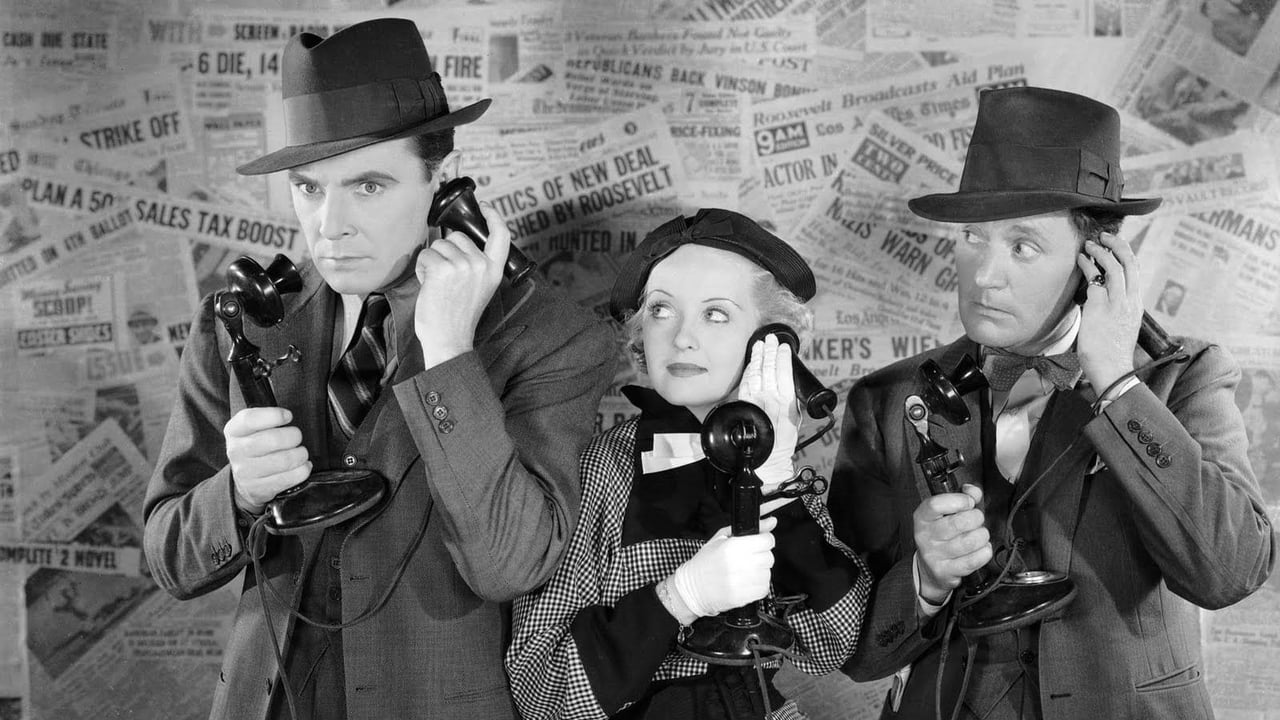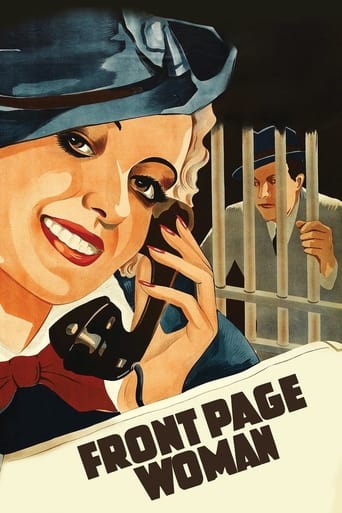



I love this movie so much
A brilliant film that helped define a genre
It really made me laugh, but for some moments I was tearing up because I could relate so much.
View MoreAfter playing with our expectations, this turns out to be a very different sort of film.
View MoreBy the time she made this film, Bette Davis had been in more than two dozen movies, and she had attained leading lady status. Never known or remembered for comedy, she nevertheless made several comedies and this is one of her early ones. In "Front Page Woman," Davis has the looks and smarts that make her a competing "newspaperman," to rival journalist and boyfriend George Brent. Davis plays Ellen Garfield and Brent is Curt Devlin. A good supporting cast is headed by Roscoe Karns as Toots, a news photographer. All the cast are good and Ellen and Curt have a friendly rivalry for getting the front-page story. At times they are very serious, but love is in the making with these two. As the plot unfolds here, the two match wits to solve a crime and get the big front-page splash ahead of the cops and one another.It's a fun story and the leads have very good chemistry. Davis smiles a lot in this film – something moviegoers didn't see very often with this giant of the silver screen over five decades in her many serious, dramatic and mystery roles. It's nice to see Davis with Brent, whom she considered among her favorite leading men. It's easy to see why he was her favorite in this film. He has an affable, kind persona here, even as an otherwise shrewd and accomplished reporter. Most people should enjoy this film.
View MoreMemo to Michael Curtiz (director): Before you begin filming, decide whether your story is a drama or a comedy.From my perspective, that's the main problem that kept this good film from being great. I see it more as a drama, yet others see it more as a comedy. And that confusion is often a problem for a film. Yes, you can have moments of drama in a comedy. And, yes, you can have levity in a drama. But movies with split personalities don't often work, or at least (as in this case) don't work as well as they could. And just for the record, this would have been best as a straight drama.On the other hand, the screen pairing of Bette Davis and George Brent was beginning to mature here. In 1934 -- just a year earlier -- they were paired in "Housewife". There, they were just two actors in the same film. Here, just one year later, they are developing that on-screen rapport that was magic in so many movies. Oh, it's not quite there yet, but in this film you begin to think that you'd like to see them together more.In terms of supporting cast, I found Roscoe Karns as the wise-cracking photographer a bit annoying. One out of every ten wisecracks were actually funny. The other supporting actors do their jobs, but none stand out. However, you will recognize quite a few faces.Overall, a pretty good movie, though not one of the classic Davis - Brent efforts.
View More"Front Page Woman" (1935) uses the same feminist "rivals in business; partners in love" motif that "Traveling Saleslady" (1935) does. However, "Woman" is a murder mystery involving reporters; "Saleslady" is a comedy involving salespersons. Still, it's interesting to compare the two.Both films have great supporting performances, excellent pacing, and flawless plots. Playing masters of their fields, both leading men (George Brent) and (William Gargan) perform well. Indeed, a surprisingly animated Brent does, for him, an absolutely charming job. (Perhaps the mutual sexual attraction he and Davis had was the spark behind it.) Where the films differ, however, is in their leading ladies' performances, and in their romantic resolutions.Bette Davis, like Joan Blondell, keeps claiming she is her rival's equal. But clearly, unlike Blondell, she is not. She doesn't have Brent's creative mind, his street smarts, his social skills, or his stomach for the job (she faints, for example, at the execution she demanded to attend). When he offers her help, she turns him down, and when, out of revenge, he sets traps for her, she falls into them.The film's end, however, does offer redemption. Not only does Davis solve the mystery, and get her job back--she also gets her man. Brent, in a rare feminist resolution for its time, tells her how much he respects what she has done, and seems willing to have her continue working after marriage. (One wonders how much the steel-willed Davis influenced this outcome?) Whether she chooses to, however, is more ambiguous. While Blondell, in stark contrast, blithely tosses away a terrific sales career to placate her "oinky" husband to be.
View MoreBette Davis seems miscast as a hard-working dynamic reporter in a rivalry with star reporter, George Brent, who works for a different newspaper. The role is more suited to wise-cracking, fast-talking stars such as Glenda Farrell (who made a similar film, Blondes at Work (1938)), or Joan Blondell (who also made a similar film, Back in Circulation (1937)). Her make-up, too, belied her profession. With perfectly tweezed eyebrows and immaculately applied lipstick, she looked like, as well as sounded like, a Hollywood star rather than a reporter. Still, Bette Davis is always a pleasure to watch even if not perfect. She and Brent are supposedly in love, but she won't marry him until he admits she is just as good a reporter as he is. You would think he wouldn't place any obstacles in her path towards reporting equality, but his vanity won't allow that conclusion, so he does. After a jury comes to a "guilty" verdict in the trial both are covering, and the jurors leave the jury room, Brent sneaks in to examine the ballots so he can get an extra on the street as quickly as possible. But sensing Davis is following him, he replaces the ballots with ones that read "not guilty." With friends like that, who needs enemies? Davis does report the wrong verdict to her editor, leading to the two rival newspapers coming out at the same time with opposite verdicts. Davis gets fired because of this hostile and vicious act, but, of course, it's not the end of the story, and she does get the last laugh in the matter.
View More